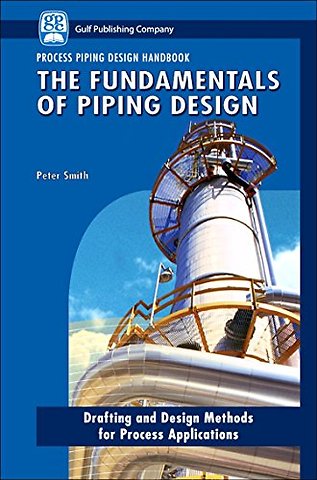<br>List of Figures</br><br>List of Tables</br><br>Foreword</br><br>Preface</br><br>1 Piping Codes, Standards, and Specifications</br><br> 1.1 Introduction</br><br> 1.2 Definitions</br><br> 1.3 Codes</br><br> 1.3.1 American Society of Mechanical Engineers Boiler Pressure Vessel Codes</br><br> 1.3.2 American Society of Mechanical Engineers B31, Codes for Pressure Piping</br><br> 1.4 Standards and Specifications</br><br> 1.4.1 American Society of Mechanical Engineers</br><br> 1.4.2 American Petroleum Institute</br><br> 1.4.3 American Society for Testing and Materials</br><br> 1.4.4 American Society for Nondestructive Testing</br><br> 1.4.5 American Society for Quality</br><br> 1.4.6 American Welding Society</br><br> 1.4.7 American Water Works Association</br><br> 1.4.8 Copper Development Association</br><br> 1.4.9 Compressed Gas Association</br><br> 1.4.10 Canadian Standards Association</br><br> 1.4.11 Expansion Joint Manufacturers Association</br><br> 1.4.12 Manufacturers Standardization Society of the Valve and Fittings Industry</br><br> 1.4.13 National Association of Corrosion Engineers</br><br> 1.4.14 National Fire Protection Association</br><br> 1.4.15 Pipe Fabrication Institute</br><br> 1.4.16 Society of Automotive Engineers</br><br>2 Piping Components</br><br> 2.1 Introduction to Piping Components</br><br> 2.2 Pipe</br><br> 2.2.1 Pipe Sizes</br><br> 2.2.2 Pipe Ends</br><br> 2.3 Pipe Fittings</br><br> 2.3.1 Butt-Weld End Fittings</br><br> 2.3.2 Socket-Weld and Threaded-End Fittings</br><br> 2.3.3 Flanged Joints</br><br> 2.4 Valves</br><br> 2.4.1 Valve Codes and Standards</br><br> 2.4.2 Classification of Operation Valves</br><br> 2.4.3 Valve Classification</br><br> 2.4.4 Valve Components</br><br> 2.5 Bolts and Gaskets (Fasteners and Sealing Elements)</br><br> 2.5.1 The Process of Joint Integrity</br><br> 2.5.2 Flange Joint Components</br><br> 2.5.3 The Flanged Joint System</br><br>3 Metallic Materials for Piping Components</br><br> 3.1 Properties of Piping Materials</br><br> 3.1.1 Chemical Properties of Metals</br><br> 3.1.2 Mechanical Properties of Metals</br><br> 3.1.3 Elongation and Reduction of Area</br><br> 3.1.4 Physical Properties of Metals</br><br> 3.2 Metallic Materials</br><br> 3.3 Alloying of Steel</br><br> 3.4 Types of Steel</br><br> 3.4.1 Mild (Low-Carbon) Steel</br><br> 3.4.2 Medium-Carbon Steel</br><br> 3.4.3 High-Carbon Steel</br><br> 3.4.4 High-Tensile Steel</br><br> 3.4.5 Stainless Steel</br><br> 3.5 Steel Heat-Treating Methods</br><br> 3.5.1 Annealing</br><br> 3.5.2 Normalizing</br><br> 3.5.3 Hardening</br><br> 3.5.4 Tempering</br><br> 3.6 Nonferrous Metals in Alloying</br><br> 3.7 Material Specifications</br><br> 3.7.1 American Society for Testing and Materials</br><br> 3.7.2 Unified Numbering System of Ferrous Metals and Alloys</br><br>4 Roles and Responsibilities</br><br> 4.1 The Lead Piping Engineer</br><br> 4.2 Piping Materials Engineering Group</br><br> 4.2.1 Project Lead Piping Materials Engineer</br><br> 4.2.2 Senior Piping Materials Engineer</br><br> 4.3 Piping Design Group</br><br> 4.3.1 Project Piping Area/Unit Supervisor (Squad Boss)</br><br> 4.3.2 Project Piping CAD Coordinator</br><br> 4.3.3 Project Piping Designers-Checkers</br><br> 4.4 Piping Materials Control Group</br><br> 4.4.1 Project Lead Piping Materials Controller</br><br> 4.4.2 Project Piping Materials Controller</br><br> 4.5 Piping Stress Engineering Group</br><br> 4.5.1 Project Lead Piping Stress Engineer</br><br> 4.5.2 Project Piping Stress Engineer</br><br> 4.6 Other Engineering Disciplines Involved</br><br> 4.6.1 Process Engineering</br><br> 4.6.2 Mechanical Engineering</br><br> 4.6.3 Instrument Engineering</br><br> 4.6.4 Civil Engineering</br><br> 4.6.5 Structural Engineering</br><br>5 Projects</br><br> 5.1 Project Types</br><br> 5.2 Project Phases</br><br> 5.2.1 Feasibility Phase</br><br> 5.2.2 Conception Phase</br><br> 5.2.3 Front-End Engineering Development Phase</br><br> 5.2.4 Detailed Engineering Phase</br><br> 5.2.5 Construction Phase</br><br> 5.2.6 Precommissioning and Commissioning Phase</br><br> 5.2.7 Startup and Handover to the Owner</br><br>6 Fabrication, Assembly, and Erection</br><br> 6.1 Codes and Standards Considerations</br><br> 6.2 Fabrication Materials for Piping Systems</br><br> 6.3 Fabrication Drawings</br><br> 6.4 Fabrication Activities</br><br> 6.4.1 Cutting</br><br> 6.4.2 Beveling</br><br> 6.4.3 Forming</br><br> 6.4.4 Bending</br><br> 6.5 Welding</br><br> 6.5.1 Welding Processes</br><br> 6.5.2 Preheating</br><br> 6.5.3 Heat Treatment</br><br> 6.6 Brazing and Soldering</br><br> 6.7 Protection of Carbon Steel in Corrosive Services</br><br> 6.7.1 Corrosion Allowance</br><br> 6.7.2 Internal Galvanizing of Pipe and Piping Systems</br><br> 6.7.3 Pipe Cladding</br><br> 6.8 Assembly and Erection</br><br> 6.8.1 Alignment</br><br> 6.8.2 Flanged Joints</br><br> 6.8.3 Threaded Joints</br><br>7 Inspection and Testing</br><br> 7.1 Piping Codes</br><br> 7.2 Types of Examination</br><br> 7.2.1 Visual Examination</br><br> 7.2.2 Liquid Penetrant Examination</br><br> 7.2.3 Magnetic Particle Examination</br><br> 7.2.4 Radiographic Examination</br><br> 7.2.5 Ultrasonic Examination</br><br> 7.3 Testing of Piping Systems</br><br> 7.3.1 Some Limitations on the Pressure Testing of Piping Systems</br><br> 7.3.2 Special Provisions for Testing</br><br> 7.3.3 Preparation for Leak Test</br><br> 7.4 Leak-Testing Methods</br><br> 7.4.1 Hydrostatic Leak Test</br><br> 7.4.2 Pneumatic Leak Test</br><br> 7.4.3 Combination Hydrostatic-Pneumatic Leak Test</br><br> 7.4.4 Initial Service Leak Testing</br><br> 7.5 Choice of Testing Medium</br><br> 7.6 Test Pack</br><br> 7.7 Punch List</br><br>A Listed Material</br><br> A.0.1 Ferrous Metals</br><br> A.0.2 Nonferrous Material</br><br> A.1 American Petroleum Institute</br><br>B General Engineering Data</br><br>Index</br>
